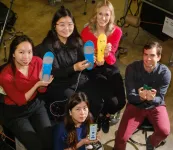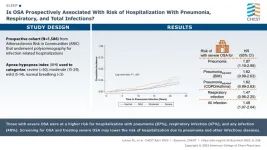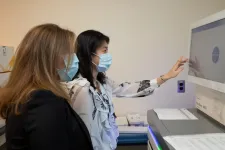(Press-News.org) Ann Arbor, April 13, 2023 – Reducing caloric intake from added sugars is a Leading Health Indicator in Healthy People 2030, a national public health initiative led by the US Department of Health and Human Services that sets data-driven national objectives to improve health and wellbeing over the next decade. Although many Americans consume too much sugar, investigators found that only a modest reduction in added sugars intake is needed to reach a population mean of 11.5% of calories from added sugars by 2030. Prioritizing reducing added sugars intake among people not meeting recommendations could help those most at risk for chronic disease related to added sugars consumption. They report their findings in the American Journal of Preventive Medicine.
“Diets high in added sugars are associated with adverse health outcomes such as obesity, type 2 diabetes, and cardiovascular disease,” said Ellen W. Stowe, PhD, MPH, lead investigator and fellow, Oak Ridge Institute for Science and Education, Oak Ridge, TN, USA. “We wanted to study what kind of reduction in added sugars intake was needed to achieve this Healthy People 2030 target.”
Although the consumption of added sugars has declined in the United States, many Americans still consume too much. The average added sugar consumption of persons two years and older in 2013–2016 was 13.5% of total calories. Less than half the population -- only about 35% of children aged two to 19 years and 47% of adults 20 years and older -- met the 2020–2025 Dietary Guidelines for Americans (DGA) recommendation of less than 10%.
Four public health approaches analyzing specific segments of the population were used to estimate the required reduction in added sugars intake needed to achieve the Healthy People 2030 target. Added sugars intake was examined before and after reduction by sociodemographic characteristics using survey data from the 2015–2016 and 2017–2018 cycles of the National Health and Nutrition Examination Survey (NHANES), a nationally representative sample of the noninstitutionalized civilian US population.
Depending on the approach used, investigators found that calories from added sugars need to decrease by an average of 14 to 57 calories per day per person in order to meet the Healthy People 2030 target.
Approach 1: General United States population – decrease by an average of 13.7 calories/day
Approach 2: People exceeding the 2020–2025 Dietary Guidelines for Americans (DGA) recommendation for added sugars (>10% calories from added sugars) – decrease by an average of 22 calories/day
Approach 3: People exceeding the 2020–2025 DGA recommendation for added sugars by at least 1.5 times (≥15% calories from added sugars, i.e., high consumers of added sugars) – decrease by an average of 56.6 calories/day
Approach 4: People exceeding the DGA recommendation for added sugars with two different reductions based on added sugars intake – decrease by an average of 13.9 and 32.3 calories/day for people consuming 10 to <15% and ≥15% calories from added sugars, respectively
Significant differences by age, race/ethnicity, and income observed pre-reduction persisted after different added sugars reductions were applied based on the four approaches.
“The results from our study were encouraging,” said Dr. Stowe. “Regardless of which of the four approaches was used in this analysis, meeting the Healthy People 2030 added sugars target is achievable with modest reductions in added sugars intake. At most, this represents just less than half of one 12-ounce soft drink. This is important because a major change in diet would not be needed to achieve the target.”
END
Good news! Only a modest reduction in added sugars consumption is needed to achieve the Healthy People 2030 target
Results from a new study published in the American Journal of Preventive Medicine show eliminating an average of 14 to 57 calories per day from added sugars will achieve the Healthy People 2030 added sugars target
2023-04-13
ELSE PRESS RELEASES FROM THIS DATE:
T-cell vaccine for COVID-19 may last longer than current vaccines
2023-04-13
UNIVERSITY PARK, Pa. — The current COVID-19 vaccines are designed to trigger an antibody response to the SARS-CoV-2 spike protein, which is vulnerable to mutations that could make the vaccine less effective over time. Focusing on the T-cell instead, Penn State researchers partnered with Evaxion Biotech on a study that was the first to demonstrate the effectiveness of an artificial intelligence-generated vaccine in a live viral challenge model. Such a vaccine may provide long-lasting immunity against future emerging variants and could be used as a model for other seasonal viral diseases ...
Rice U. students engineer socks for on-the-go neuropathy treatment
2023-04-13
HOUSTON – (April 13, 2023) – Need a little spring — or buzz — in your step? A wearable electrical-stimulation and vibration-therapy system designed by Rice University engineering students might be just what the doctor ordered for people experiencing foot pain and balance loss due to diabetic neuropathy.
Rice engineering students in the StimuSock team — Abby Dowse, Yannie Guo, Andrei Mitrofan, Sarah Park and Kelly Xu — designed a sock with a smart insole that can deliver both transcutaneous electrical nerve stimulation (TENS) and vibration therapy that block pain signals to the brain and ...
UC Davis study finds tweets can amplify, disrupt, unite and divide
2023-04-13
Social media connects people and amplifies different aspects of humanity in good and bad ways. But the effects of social media appear neither universally good nor bad, but rather present an oscillating, dynamic system that can be divisive but also uniting, a new University of California, Davis, study suggests.
Department of Communication researchers said their findings both in an observational study and simulation speak to the ongoing debate about social media’s contributions to political polarization, misinformation and echo chambers. To conduct their research, ...
Highlights from the journal CHEST®, April 2023
2023-04-13
Glenview, Illinois – Published monthly, the journal CHEST® features peer-reviewed, cutting-edge original research in chest medicine: Pulmonary, critical care and sleep medicine and related disciplines. Journal topics include asthma, chest infections, COPD, critical care, diffuse lung disease, education and clinical practice, pulmonary vascular disease, sleep, thoracic oncology and the humanities.
The April issue of the CHEST journal contains 50 articles, including clinically relevant research, reviews, case series, commentary and more. ...
First-in-Canada clinical RNA sequencing platform may improve rare disease diagnostics in pediatrics
2023-04-13
A new clinical RNA sequencing platform at The Hospital for Sick Children (SickKids) is helping to facilitate research into rare genetic conditions and carve a path for Precision Child Health, a movement at SickKids to deliver individualized care for every patient.
RNA sequencing provides a different way of looking at the genes, by looking at how the body interprets the genetic code rather than looking directly at the genetic code itself. While DNA-based tests like genome sequencing take a picture of a person’s genetic code, scientists can better understand how the DNA is being read by also looking at RNA, which carries instructions for making ...
Durability of bivalent boosters against Omicron subvariants
2023-04-13
(CHAPEL HILL, N.C., April 13, 2023) New research led by the UNC Gillings School of Global Public Health shows that bivalent COVID-19 boosters are still providing effective protection from hospitalization and death, even against the most recent omicron subvariants.
Published this week in the New England Journal of Medicine (NEJM), researchers found that the bivalent boosters were 67% effective in preventing hospitalization and death in those who had been previously vaccinated or boosted. Effectiveness waned to 48% after four weeks, 44% after 10 weeks and 38% after 20 weeks.
Though ...
Improving the accuracy of near-infrared fluorescence in cardiovascular imaging
2023-04-13
Cardiovascular diseases (CVDs) or heart diseases are still the leading cause of death globally. Fortunately, doctors are now equipped with more advanced and sophisticated tools that help them diagnose CVDs. A prominent example is intravascular ultrasound (IVUS), which enables cardiologists to obtain images of the inside of blood vessels using a thin ultrasound probe. These images can then be used to assess problems such as the thickening of arteries caused by fat or plaque buildup.
While IVUS is undoubtedly a powerful ...
New tool to study hepatitis B could open the door to a cure
2023-04-13
Hepatitis C and hepatitis B viruses both attack the liver, eventually causing deadly cirrhosis or cancer. But while antivirals can cure 95 percent of HCV infections, its cousin HBV has long eluded effective therapeutics. As a result, nearly 1 million people die from HBV every year.
Now researchers from the lab of Rockefeller’s Charles M. Rice—who shared the 2020 Nobel Prize in Physiology or Medicine for pioneering novel methods to grow and study HCV—have developed an approach for studying HBV in the lab that ...
Biological bouncers: How immune cells yank antigens from surfaces to learn and evolve
2023-04-13
Most cells evolve slowly, accumulating incremental changes that better suit their environments. Immune cells, because they must adapt rapidly to counter new threats, evolve much more quickly. Part of that, UCLA physicists now report, rests on their ability to forcibly pull antigens off other cells’ surfaces and “study” them.
By using this type of mechanical force, the immune system’s B cells, which create antibodies that fight off harmful pathogens like viruses, bacteria and parasites by targeting their ...
OHSU researchers assemble comprehensive atlas of gene mutations in human tissue
2023-04-13
Researchers have created the largest atlas of post-zygotic genome mutations in healthy human tissue ever assembled — a scientific advancement that could unlock new avenues for diagnosing and treating genetic disease. It is the largest ever in terms of the combined number of tissues and number of donors sampled.
The study, led by researchers at Oregon Health & Science University, published today in the journal Science.
The development points the way toward understanding the genetic underpinnings of disease associated with cancer as well as innumerable conditions caused by cellular malfunction, including ...
LAST 30 PRESS RELEASES:
Two Keck Medicine of USC Hospitals named Leapfrog Top Teaching Hospitals
World-first discovery uncovers how glioblastoma tumours dodge chemotherapy, potentially opening the door to new treatments
A fatal mix-up: How certain gut bacteria drive multiple sclerosis
New AI tool identifies not just genetic mutations, but the diseases they may cause
Deep-learning model predicts how fruit flies form, cell by cell
Combination pills for high blood pressure may simplify treatment, improve long-term health
Immune system keeps mucosal fungi in check
Neurons within the brain use simple rules to localize genetic messages
Electrodes created using light
Second-hand gift-giving is a well-deliberated decision
How human interaction drove evolution to make bears less aggressive
National Poll: Few parents offer teens guidance on healthy eating during holiday season
Cannabis derivatives could provide new ovarian cancer treatments
Raising strong yeast as a petroleum substitute
Clues to the origin of hot Jupiters hidden in their orbits
Canada’s reduced pledge to Global Fund will impact domestic health
1 in 4 children with major traumatic injuries not cared for in pediatric trauma centres
Duke and Duke-NUS’ joint cross-population research to uncover "East-West" differences in disease and care
Scientists to ‘spy’ on cancer- immune cell interactions using quantum technology breakthrough
Tech savvy users have most digital concerns
Making lighter work of calculating fluid and heat flow
Normalizing blood sugar can halve heart attack risk
Lowering blood sugar cuts heart attack risk in people with prediabetes
Study links genetic variants to risk of blinding eye disease in premature infants
Non-opioid ‘pain sponge’ therapy halts cartilage degeneration and relieves chronic pain
AI can pick up cultural values by mimicking how kids learn
China’s ecological redlines offer fast track to 30 x 30 global conservation goal
Invisible indoor threats: emerging household contaminants and their growing risks to human health
Adding antibody treatment to chemo boosts outcomes for children with rare cancer
Germline pathogenic variants among women without a history of breast cancer
[Press-News.org] Good news! Only a modest reduction in added sugars consumption is needed to achieve the Healthy People 2030 targetResults from a new study published in the American Journal of Preventive Medicine show eliminating an average of 14 to 57 calories per day from added sugars will achieve the Healthy People 2030 added sugars target




